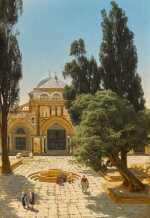The Orientalist Sale
The Orientalist Sale

Carl Cowen Schirm
The Al-Aqsa Mosque, Jerusalem
Auction Closed
April 25, 02:17 PM GMT
Estimate
40,000 - 60,000 GBP
Lot Details
Description
Carl Cowen Schirm
German
1852 - 1928
The Al-Aqsa Mosque, Jerusalem
signed and dated C.C. Schirm. 1884. lower right
oil on panel
Unframed: 55 by 37.5cm., 21¾ by 14¾in.
Framed: 75 by 59cm., 29½ by 23¼in.
Sale: im Kinsky, Vienna, 6 December 2022, lot 338
Purchased from the above sale by the present owner
This view south from the Dome of the Rock depicts the north entrance elevation of the Al-Aqsa mosque, among the three holiest sites in Islam. Muslims believe that Muhammad was transported from the Sacred Mosque in Mecca to al-Aqsa during the Night Journey. In the middle foreground the main ablution fountain, known as al-Kas ('the Cup') can be seen. It is used by worshipers to perform wudu, a ritual washing of the hands, arms, legs, feet, and face before entry into the mosque. It was first built in 709 by the Umayyads, but in 1327–28 Governor Tankiz enlarged it to accommodate more worshippers. It was originally supplied with water from Solomon's Pools near Bethlehem.
Carl Cowen Schirm was born in Wiesbaden in Hessen and studied chemistry and physics in Bonn before entering the Karlsruhe Art Academy in 1874, where he was a pupil of the Norwegian landscape painter Hans Fredrik Gude. There he met Eugen Bracht and Adolf Meckel, who, like him, were fascinated by the Middle-East.
The idea of a trip to the Orient took shape between the three friends at this time, and in 1880 they set off for Syria, visiting the shores of the Caspian Sea and Mount Sinai, which provided them with new inspiration. In contrast to Bracht and Meckel, Schirm's Orientalist works occupy only a small place in his landscape corpus.
